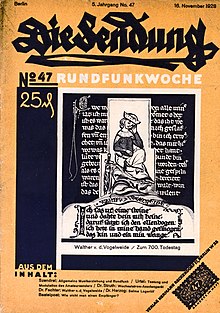Publisher Hermann Reckendorf
The Hermann Reckendorf publishing in 1918 in Berlin by the German-Jewish book printing, commercial artist and a publisher Hermann Reckendorf established (1880-1936).
Hermann Reckendorf developed his publishing house into one of the leading publishing houses in Germany in a relatively short time. 96 percent of the shares were family-owned. The publisher was well known, especially because of its permanent exhibitions to promote young art and artistic endeavors ( Kunstblatt exhibition of young artists ), especially since Paul Westheim's Kunstblatt appeared here from 1927 . The company was based in the four-story Reckendorf house at Hedemannstrasse 24 in Berlin-Kreuzberg, which was built as an office building as early as 1912/13 . Members of the Deutscher Werkbund, such as the architects Ludwig Hilberseimer , Prof. Lucian Bernhard and Fritz Schopohl , played a key role in the design of the interior of the publishing house. The publishing house employed around 100 people, for whom Hermann Reckendorf had a kitchen and a casino built on the fourth floor of the house. The laboratory rooms for the radio magazines and the central radio system as well as the offices of the Deutscher Werkbund were also located there. In 1916 Reckendorf was appointed to head the war propaganda, which he was able to carry out successfully. He later led the propaganda for women's suffrage . He was involved in the establishment of the Reich Central Office for Homeland Service and organized border donations and welfare for prisoners of war . At the German Trade Show in Munich in 1922 and at the Leipzig Trade Fair from 1920 to 1922 he played a major role. The Technical University of Stuttgart named Hermann Reckendorf an honorary doctorate because of his pioneering work in the field of broadcast technology in the 1920s .
On May 1, 1930, the Berlin Gauleitung Berlin of the NSDAP moved into the building at Hedemannstrasse no. 10. In addition, from April onwards, the group leadership of the SA group Berlin-Brandenburg was quartered at Hedemannstrasse no. 31 for almost a year . For the progressive publisher with a program like Hermann Reckendorf - publications on contemporary art and design issues and the publication of radio magazines as well as books and brochures on radio, film and photography topics - these hostile neighbors and the beginning of the Nazi dictatorship meant the Beginning of the end. With the July number 1934, the magazine "Die Form" ceased its publication and the publisher stopped production. The management of the German Werkbund, now set up by the National Socialists, was willingly incorporated into the Reich Chamber of Fine Arts .
Reckendorf was expropriated by the Nazis as early as 1933 and his Reckendorf publishing house was "aryanized". The house became the seat of the National Socialist German Labor Front (DAF) from 1934 .
Hermann Reckendorf's name appears in the Berlin address book until 1937 under the address: “Reckendorf, Hermann, Dr.-Ing., Verlagsbuchhdl., Steglitz, Wuthenowerstr. 8 a. “The Reckendorf & Co. Verlagbuchhandlung operated under the same address until 1937. From 1938 to 1940 Reckendorf's wife Charlotte, b. Auen recorded in the Berlin address book as follows: Reckendorf, Charlotte, Wtw., Wilmersdorf, Schlangenbader Str. 80 T.
There are different versions of Hermann Reckendorf's further course of life: on the one hand it was alleged that Hermann Reckendorf went into exile with his family in Italy, in another source his suicide in 1933 was rumored; as Roland Jaeger (see sources) determined, however, he continued to live in Berlin-Steglitz, where he died - possibly by suicide - on December 23, 1936 at the age of 56.
Publisher's journals (based on information provided by the creator of the article)
- "Yearbooks of the German Werkbund", 1912 to approx. 1921
- "The broadcast", monthly. f. Art, culture, economy, etc. Technology in broadcasting. Ed .: including Georg Graf von Arco , only published in 1924
- “Die Sendung - Rundfunkwoche”, April 1924 to approx. 1941 (from approx. 1933 no longer with Reckendorfs Verlag). IDN 012847291
- "Deutsche Welle", official organ d. Rundfunk-Gesellschaft Deutsche Welle Berlin, published 1928 to May 1932
- “Die Form”, magazine for creative work for the German Werkbund and the Association of German Applied Arts and Crafts Associations, 1925–35, 1923–1924 not published, changing publishers
- “ Das Kunstblatt ” (edited by Paul Westheim ), 1927–1933 (previously other publishers), then discontinued publication
- “Television” (employee: Manfred von Ardenne ), bibliographically not verifiable
swell
- Reich Manual of the German Society . German business publishing house, 1930, 1931
- Joan Champbell: The German Werkbund. 1907-1934 , pp. 266, 299, 303; DTV / Klett-Cotta, 1989
- Berlin address book , issues 1933 to 1940
- The Reckendorf Book; Contributions z. 50th birthday v. Hermann Reckendorf. March 4, 1930 . Berlin: Advertising Service, 1930
literature
- Roland Jaeger: Advertising service for the German Werkbund: The Hermann Reckendorf publishing house, Berlin ; in: From the Antiquariat NF 5 (2007), No. 1, pp. 3–22.
- Roland Jaeger: Permanent documents of the New Vision. The Hermann Reckendorf publishing house, Berlin. In: Manfred Heiting, Roland Jaeger (Hrsg.): Autopsy. German-language photo books 1918 to 1945. Volume 1. Steidl Verlag, Göttingen, 2012, pp. 248–267. ISBN 978-3-86930-412-0
